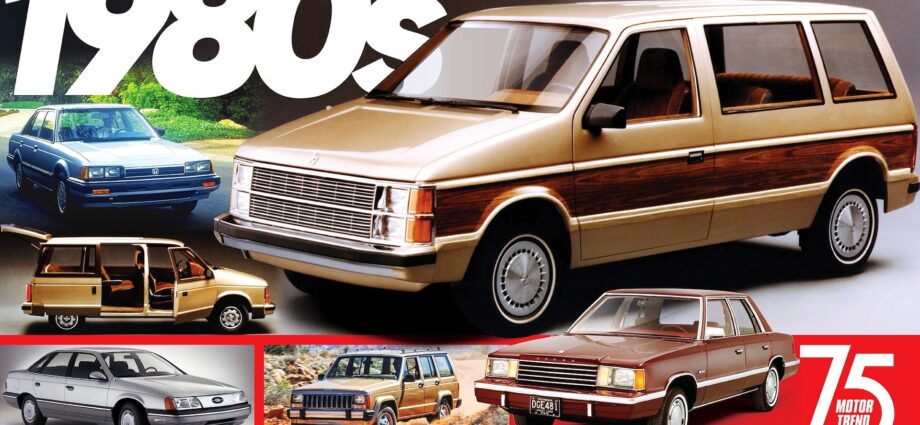As part of MotorTrend’s 75th anniversary, we look back at some of history’s most significant cars. A complete list would fill a book, so for each decade we select five notable vehicles that helped shape automotive history.
Introduction to the 1980s
The 1980s were a time of tumult and change in the Amercian automotive climate as foreign cars began to dictate, rather than reflect, what U.S. drivers wanted. As Japanese automakers moved beyond economy cars and Europe took over the luxury market, Detroit found itself reacting instead of acting, scrambling to switch to small front-drive cars while adopting ever-stricter safety and emissions standards. It wasn’t all bad, though. Thanks to the computer revolution, cars began to run better, accelerate quicker, and coddle their owners with new high-tech features. Indeed, there’s zero debating the fact the cars of 1989 felt a world away from the cars of 1979.
1981 Chrysler K-Cars
In 1979, a near-bankrupt Chrysler stoked controversy by asking the government for $1.5 billion in loan guarantees. Just more than a year later, the company introduced the Dodge Aries and Plymouth Reliant. Unlike the disastrous General Motors X-cars, the K-cars were designed and built well, and they were so successful that Chrysler was able to pay off its loans, with interest, by 1983. The K platform yielded a variety of cars from slick sport coupes like the Dodge Daytona to the revolutionary Caravan and Voyager minivans (see below). K-based products remained in the lineup well into the 1990s, and while car fanatics got sick of platform proliferation, there is no question the innovative K-cars saved Chrysler, and in record time. The K’s influence can be felt even now, as automakers create a variety of electric vehicles at low cost by mating wildly different bodies to a common skateboard chassis.
1982 Honda Accord
Japanese automakers made their bones on economy cars during the energy crisis, but the second-generation Honda Accord was arguably the first Japanese offering with real relevance for American families. Bigger and more luxurious than the original Accord, the new version expanded the car’s appeal and exposed a larger buyer base to levels of quality, longevity, engineering efficiency, and attention to detail heretofore unimagined by many American car buyers. Import car boosters claimed American workers could not achieve the same level of quality as Japanese ones, but the Accord proved them wrong: Starting in 1982, the Accord became the first Japanese car built in America, and locally grown Accords from Honda’s Marysville, Ohio, plant matched the quality of their Japanese-made siblings. The Accord continued to grow in both size and importance, becoming a dominant force in what would soon become the industry’s leading vehicle segment.
1984 Dodge Caravan and Plymouth Voyager
It only took a matter of months for Chrysler’s “garageable van” to break the station wagon’s stranglehold as America’s family car of choice. Based on Chrysler’s K-car platform, the spacious body of the front-wheel-drive Caravan and Voyager felt like a living room on wheels, providing a sense of family togetherness a station wagon could not—all while being more fuel efficient and easier to park. Sales exploded, and while automakers on both sides of the Pacific rushed to field competitors, a series of improvements kept the Chrysler vans one step ahead. Even the supposedly invincible Japanese automakers could not come up with a van that put so much as a dent in Chrysler minivan sales. Trendy parents eventually began to rebel against the “minivan mom” stereotype, fueling the SUV’s ultimate rise, but minivans remain relevant as family haulers right up to this day.
1984 Jeep Cherokee
The “XJ” Cherokee was just one member of the class of new compact off-roaders, but Jeep owner AMC (Chrysler acquisition was still in the future) was smart enough to launch both two- and four-door versions from the get-go. It was also smart enough to listen to corporate partner Renault on issues of suspension arrangement and tuning, which gave the Cherokee a roomy interior and belief-defying on-road handling from its twin-live-axle arrangement. The Cherokee had instant appeal—it won its very first MotorTrend comparison test—and as SUVs became the hot ticket, Jeep pushed the Cherokee upmarket with gold trim and BBS-style wheels. The Cherokee rode the rising SUV wave like Kelly Slater, becoming a model of success other automakers strove to follow. It remained so popular that even after its supposed successor, the Grand Cherokee, made its debut in 1993, the XJ remained in production right into the new millennium, and it remains a favorite of hardcore off-road enthusiasts.
1986 Ford Taurus
By the mid-80s, it was common knowledge among grumbling American car buyers that the domestics couldn’t build a car anywhere near as good as the Japanese—and then the 1986 Ford Taurus (and its upscale sibling, the Mercury Sable) came along. These cars had it all: futuristic styling, smooth-running fuel-injected engines, a spacious, ergonomic cabin, and—most important—quality. Ford adopted the teachings of W. Edwards Deming, an expert in quality control whose postwar work was largely ignored by his fellow Americans and embraced by the Japanese. Named MotorTrend’s 1986 Car of the Year, the Taurus proved American workers could compete with the Japanese on engineering and build quality. While the Japanese brands saw huge gains in the family car market, the Taurus remained a constant thorn in their sides, with Ford selling more a million copies by decade’s end.
MotorTrend thanks Matt Anderson, automotive historian and curator of transportation at The Henry Ford Musem of American Innovation, for his assistance with our Most Significant Cars of the Decades series.

